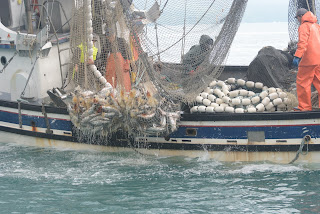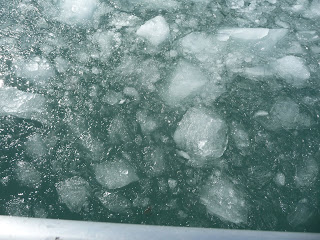We were originally scheduled for four days in Valdez, but
we were able to arrive a day early and leave a day late. The early fog soon
gave way to crystal clear sunshine. Our host had our sites ready and waiting
and immediately filled us in on all the possible activities and attractions.
Primarily our activity will involve fishing. The “Pinks are in” and Rob and
Steve can hardly wait to throw out a line. The Pinks being in means the Pink
Salmon are running up river to the place they were born, which in this instance
means the fish hatchery across the bay.
Just down the street, in a residential area and near the
hospital (in case we need one) is a large dog park. The park was empty and
Nugget and Charlie had a chance to stretch out their legs with some quality
running around time. Charlie was even tolerating Nugget without curling his
lip.
 |
| Charlie |
Judy, our hostess, pointed to a grassy (read that “weedy”)
area next to the RV park and said we could run the dogs there if we wanted, but
we should be aware that a bear had been taken out of there in the last couple
of days. Later that evening I noticed a bear trap had been reinstalled with
warning signs to keep away. Everett, our host, said the idea that there’s
another bear in the area is ridiculous and a waste of time so not to worry.
Saturday again dawned sunny and clear. Today was the kid’s
fishing derby so the prime fishing spots will be taken by kids until 5 pm. We
drove over to the other side of the bay next to the fishery to see what was
what. Both sides of the street were end to end cars, campers and trailers. Kids
were trying their luck at fishing with the hope of winning the derby. The tide
was still going out so anyone who was fishing was standing in shallow water.
Several participants were displaying their fish on stringers or in plastic bags
or buckets. Some of the “kids” looked more like young adults, but I guess they
qualified. We never did hear who won the derby.
We arrived back at the RV park just in time to witness
another bear being taken away in the trap. The police and animal control had
captured another black bear and were getting ready to transport. Our host was
slightly chagrined.
 |
| Other wildlife in the area |
Fishing was scheduled that night over by the fish hatchery. Hopefully, the kids left some. Rob and Steve went over about 7pm to catch the incoming tide. They tried for a couple of hours before giving up with no luck. Jeannie and I watched from a couple of rocks above the water line.
Sunday was devoted to a glacier and wildlife cruise on the
LuLu Belle.
Rob and I had taken this cruise 11 years ago and were excited to go again. The boat departs at 11 am for a seven hour cruise, unless the captain, Captain Fred Rodolf, finds sights to keep him, and us, out longer. (like whales!)
There was alread a long line of cruisers waiting to board the boat.
Capt. Fred has been running this tour since 1979 and has a running monologue to entertain his guests. The only time he was silent on the entire trip was when we were floating in the ice fields.
Rob and I had taken this cruise 11 years ago and were excited to go again. The boat departs at 11 am for a seven hour cruise, unless the captain, Captain Fred Rodolf, finds sights to keep him, and us, out longer. (like whales!)
There was alread a long line of cruisers waiting to board the boat.
Capt. Fred has been running this tour since 1979 and has a running monologue to entertain his guests. The only time he was silent on the entire trip was when we were floating in the ice fields.
As we slowly left the harbor we passed a “tender”.
The “tender”, (a much larger boat), relieves the commercial fishing boats of their catch, weighs it, and when full, transports the fish to the processing plant. Capt. Fred pulled up alongside one that was waiting for another load. The two crew members on deck were quite animated in showing us what their jobs were.
The “tender”, (a much larger boat), relieves the commercial fishing boats of their catch, weighs it, and when full, transports the fish to the processing plant. Capt. Fred pulled up alongside one that was waiting for another load. The two crew members on deck were quite animated in showing us what their jobs were.
After exiting the harbor we spied a smaller boat that was
just in the process of pulling in its nets.

This guy was waiting for the net to be emptied. Once empty he would grab the line and take it out away from the big boat making a large circle setting up the net for another load.
The fish is processed right in Valdez. When the tender is full it will take its load to a processing plant similar to what we saw in Haines. Peter Pan is one of the processing plants in Valdez. It is a full service operation staffed largely by college students on summer break. The “campus” even has dormitories and a mess hall for its employees and a shuttle to take them to town in their off hours.

 |
| No wonder the boys didn't catch any fish! |
This guy was waiting for the net to be emptied. Once empty he would grab the line and take it out away from the big boat making a large circle setting up the net for another load.
The fish is processed right in Valdez. When the tender is full it will take its load to a processing plant similar to what we saw in Haines. Peter Pan is one of the processing plants in Valdez. It is a full service operation staffed largely by college students on summer break. The “campus” even has dormitories and a mess hall for its employees and a shuttle to take them to town in their off hours.
Continuing on the cruise, we passed groups of sea otters
lolling around on the surface.
Actually a group of otters is known as a “raft” and that’s exactly what it looked like. Some of the “rafts” had only 3-4 otters while others had more than 10-12. They had no fear of the boat getting close to them.
Actually a group of otters is known as a “raft” and that’s exactly what it looked like. Some of the “rafts” had only 3-4 otters while others had more than 10-12. They had no fear of the boat getting close to them.
We passed by several buoys loaded down with sea lions. Capt. Fred said he didn’t like them because they eat lots of salmon so we kept on going. Cruising out through the “narrows” the scene opened up with high forested cliffs on either side. We sidled up along one side and nosed into a cave in search of a Puffin which nested on a shelf in the cave. On our last visit, the Puffin was at home and we were able to photograph it. This time, no one was home. Puffins are cute little birds that actually swim under water in search of food.
After backing out of the cave we went in search of whales. On
the way we passed a large harem of sea lions relaxing on a narrow beach below a
cliff.
The large male in the bunch has number 644 painted on his body. This guy is a California Sea Lion that was caught eating salmon near the hatchery. This was totally unacceptable due to the economic impact fishing has in the area, and since sea lions are an endangered species, the Fish and Game people decided to relocate the big guy back to Southern California, along with several others, by truck. #664 made it all the way back to Valdez a few days later. I guess he’s here to stay along with his harem. (the story as related by our captain!)
The large male in the bunch has number 644 painted on his body. This guy is a California Sea Lion that was caught eating salmon near the hatchery. This was totally unacceptable due to the economic impact fishing has in the area, and since sea lions are an endangered species, the Fish and Game people decided to relocate the big guy back to Southern California, along with several others, by truck. #664 made it all the way back to Valdez a few days later. I guess he’s here to stay along with his harem. (the story as related by our captain!)
All the passengers were anxious to see a whale. Capt. Fred
said a Humpback had been seen the day before, but none the day before that.
Luck was with us and very shortly a Humpback was spotted just under the
surface.
We spent quite a while following him around as he consumed his lunch of herring. When he dove, his tail would stick up showing markings on his tail. Since the markings are individual Capt. Fred said this one had been seen often.
We spent quite a while following him around as he consumed his lunch of herring. When he dove, his tail would stick up showing markings on his tail. Since the markings are individual Capt. Fred said this one had been seen often.
After watching the whale for about an hour, we took off for
the Columbia Glacier in the Prince William Sound.
The temperature dropped dramatically once we entered the ice field.
There is no evidence of the 1989
Exxon Valdez oil spill in the Sound. The water is crystal clear. We floated around among the icebergs for a
while before heading back to dock, just barely over 7 hours at sea.
Some of the beauty of the sound!
End of part one from Valdez. Part two will continue soon, I hope!
The temperature dropped dramatically once we entered the ice field.
 |
| Jeannie and Gerri braced for the cold! |
Some of the beauty of the sound!
 |
| Sea otters on an iceberg |
 |
| Entering the icefield |
 |
| Columbia Glacier |
 |
| Columbia Glacier |
 |
| Close up of calving area |
 |
| Floating in ice |
 |
| ice cubes anyone? |
 |
| Part of the glacier covered with grit |
End of part one from Valdez. Part two will continue soon, I hope!











No comments:
Post a Comment